Frost Protection - UTL Repository
Frost Protection - UTL Repository
Frost Protection - UTL Repository
Create successful ePaper yourself
Turn your PDF publications into a flip-book with our unique Google optimized e-Paper software.
ACTIVE PROTECTION METHODS<br />
FOAM INSULATION<br />
Application of foam insulation to low growing crops for frost protection was<br />
widely studied mostly in North America and it has been shown to increase the<br />
minimum temperature by as much as 12 °C (Braud, Chesness and Hawthorne,<br />
1968). However, the method has not been widely adopted by growers because of<br />
the cost of materials and labour, as well as problems with covering large areas in<br />
short times due to inaccuracy of frost forecasts (Bartholic, 1979). Foam is made<br />
from a variety of materials, but it is mostly air, which provides the insulation<br />
properties. When applied, the foam prevents radiation losses from the plants and<br />
traps energy conducted upwards from the soil. <strong>Protection</strong> is best on the first<br />
night and it decreases with time because the foam also blocks energy from<br />
warming the plants and soil during the day and it breaks down over time. Mixing<br />
air and liquid materials in the right proportion to create many small bubbles is<br />
the secret to generating foam with low thermal conductivity. Several methods to<br />
produce foam and apply it are reported in Bartholic (1979). However, Bartholic<br />
(1979) notes that growers show an interest after experiencing frost damage, but<br />
they rarely adopt the use of foam in the long term. Recently, Krasovitski et al.<br />
(1999) have reported on thermal properties of foams and methods of application.<br />
FOGGERS<br />
Natural fog is known to provide protection against freezing, so artificial fogs<br />
have also been studied as possible methods against frost damage. Fog lines<br />
(Figure 7.15) that use high-pressure lines and special nozzles to make small (i.e.<br />
10 to 20 µm diameter) fog droplets have been reported to provide good<br />
protection under calm wind conditions (Mee and Bartholic, 1979). <strong>Protection</strong><br />
comes mainly from the water droplets absorbing long-wave radiation from the<br />
surface and re-emitting downward long-wave radiation at the water droplet<br />
temperature, which is considerably higher than apparent clear sky temperature.<br />
The water droplets should have diameters about 8 µm to optimize the<br />
absorption of radiation and to prevent the water droplets from dropping to the<br />
ground. A fairly dense cloud of thick fog that completely covers the crop is<br />
necessary for protection. This depends on the presence of light wind and<br />
relatively high humidity. For example, Brewer, Burns and Opitz (1974) and<br />
Itier, Huber and Brun (1987) found difficulties with the production of sufficient<br />
water droplets and with wind drift. Mee and Bartholic (1979) reported that the<br />
Mee foggers have energy use requirements that are less than 1 percent of heaters,<br />
about 10 percent of wind machines and about 20 percent of sprinklers. They<br />
also reported better protection under some conditions than from use of heaters.<br />
183


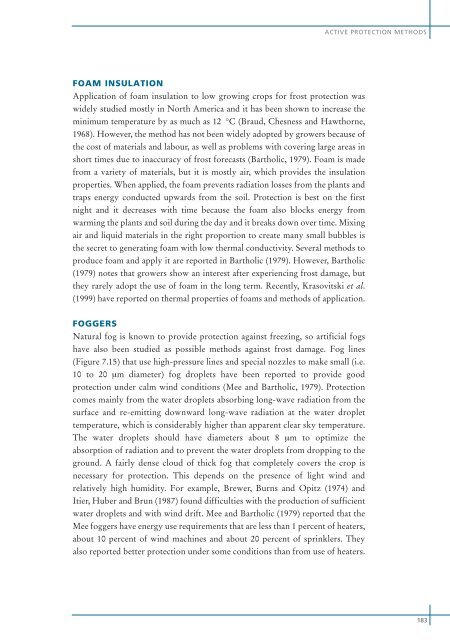
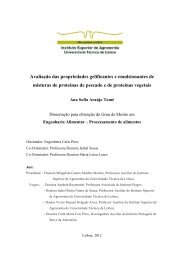
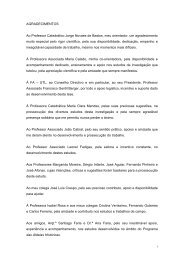
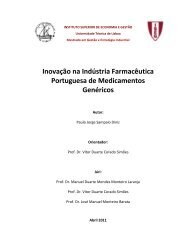
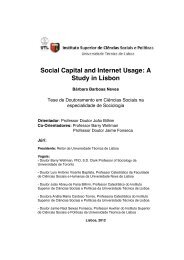
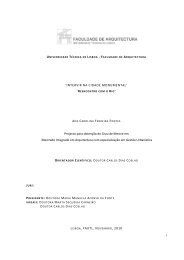
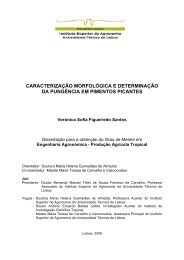

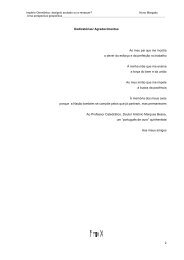
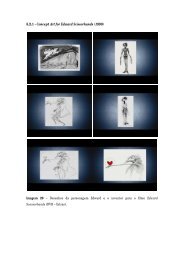
![Tese - Es..[1].pdf - UTL Repository - Universidade Técnica de Lisboa](https://img.yumpu.com/25707135/1/184x260/tese-es1pdf-utl-repository-universidade-taccnica-de-lisboa.jpg?quality=85)


